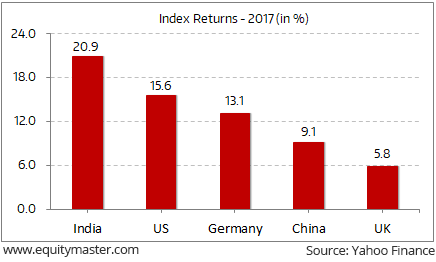- Home
- Todays Market
- Indian Stock Market News October 17, 2017
Indian Indices Trade Marginally Higher; Telecom Stocks Witness Buying Tue, 17 Oct 11:30 am
After opening the day on a firm note, stock markets in India witnessed losses and are presently trading marginally higher. Sectoral indices are trading on a mixed note with stocks in the telecom sector and capital goods sector witnessing maximum buying interest. Metal stocks are trading in the red.
The BSE Sensex is trading up 31 points (up 0.1%) and the NSE Nifty is trading up 15 points (up 0.2%). The BSE Mid Cap index is trading up by 0.4%, while the BSE Small Cap index is trading up by 0.6%. The rupee is trading at 64.91 to the US dollar.
As per an article in the Economic Times, retail investors continued to pour money into equity mutual funds through Systematic Investment Plan (SIPs) during September. This comes as monthly collection through such schemes in September touched Rs 55 billion.
For the first six months of the current year, SIP collections rose 45%, compared with the same period last year, to touch Rs 292 billion.
Most of the above buying interest in mutual funds comes on the back of the recent uptrend in Indian equity markets. Note that the Sensex has been making new highs everyday of late. In fact, amongst all major indices, the Indian stock markets have given the best returns in 2017, as can be seen from the chart below:
Global Index Returns in 2017
Back in March 2016, we had predicted Sensex to touch 40,000 within a 3 to 4 year timeframe. At this pace, it seems like Sensex might get there sooner rather than later.
However, this may not necessarily be a good thing. The current run seems to extrapolate all good news into the future and expects the ride to be smooth and consistent. But, history has shown that markets rarely work that way.
Also, note that earnings of Indian companies are currently unusually low. Even when measured against sales, the Sensex and the broader BSE 500 indices are close to their peak valuations.
Of course, some stocks could correct less than others. Blue chips, for instance, continue to trade at more reasonable valuations than small caps. Meaning their downside risk is less. But buying any stock at its all-time high, ignorant of the downside risk, could be a recipe for disaster.
In such an environment, it makes sense for investors to be selective while buying stocks and focus on value and the underlying fundamentals of the business.
Just Released: Multibagger Stocks Guide
(2017 Edition)
In this report, we reveal four proven strategies to picking multibagger stocks.
Well over a million copies of this report have already been claimed over the years.
Go ahead, grab your copy today. It's Free.

In the news from the GST space, the GST Council is considering pruning of the number of items in 28% tax bracket.
This comes as Revenue Secretary Hasmukh Adhia said that the number of goods in the highest 28% GST slab would be brought down. He also added that a committee of officers will calculate the revenue impact before going in for further reduction in tax rates.
Speaking of Goods and Services Tax (GST), the tax regime completed 100 days since its rollout last week.
Till date, nine million enterprises are registered under the GST network. Of which, 2.6 million are new GST assesses and 6.4 million taxpayers are from the past regime. The new additions signify an increase of 40% to the previous tax base.
The tax collections too have largely been met. Against the target set by government for Rs 910 billion, the tax revenue collected for August was Rs 906 billion.
While, the tax seems to benefit the organized players in a big way, it is the unorganized segment who have taken a big hit. First, it was demonetization and now it is the implementation of GST. This hit is well reflected in the gross domestic product numbers. GDP growth has slumped to 5.7% in the June quarter from a high of 7.9% clocked in the June quarter of 2016.
To boost the economic scenario, the government recently came out with certain relaxations under the goods and service tax (GST).
Apart from tax rates being reduced on twenty-seven items, the government relaxed the compliance burden on the small and medium sized enterprise (SME). SMEs with an annual turnover of less than 15 million can now fill quarterly returns, as compared to monthly returns before. Also, the annual turnover limit under the composition scheme which enables firms to pay tax at concessional rates have been raised from Rs 7.5 million to Rs 10 million.
Not only this, concerns of exporters too have largely been addressed by removal of interstate GST till March 2018 and an assurance to clear the refunds at a faster pace.
The transition to goods and service tax (GST) is a tough one and we believe if implemented properly, the tax will reap huge benefits to the listed organized companies in the long run.
For information on how to pick stocks that have the potential to deliver big returns, download our special report now!
Read the latest Market Commentary



Equitymaster requests your view! Post a comment on "Indian Indices Trade Marginally Higher; Telecom Stocks Witness Buying". Click here!
Comments are moderated by Equitymaster, in accordance with the Terms of Use, and may not appear
on this article until they have been reviewed and deemed appropriate for posting.
In the meantime, you may want to share this article with your friends!